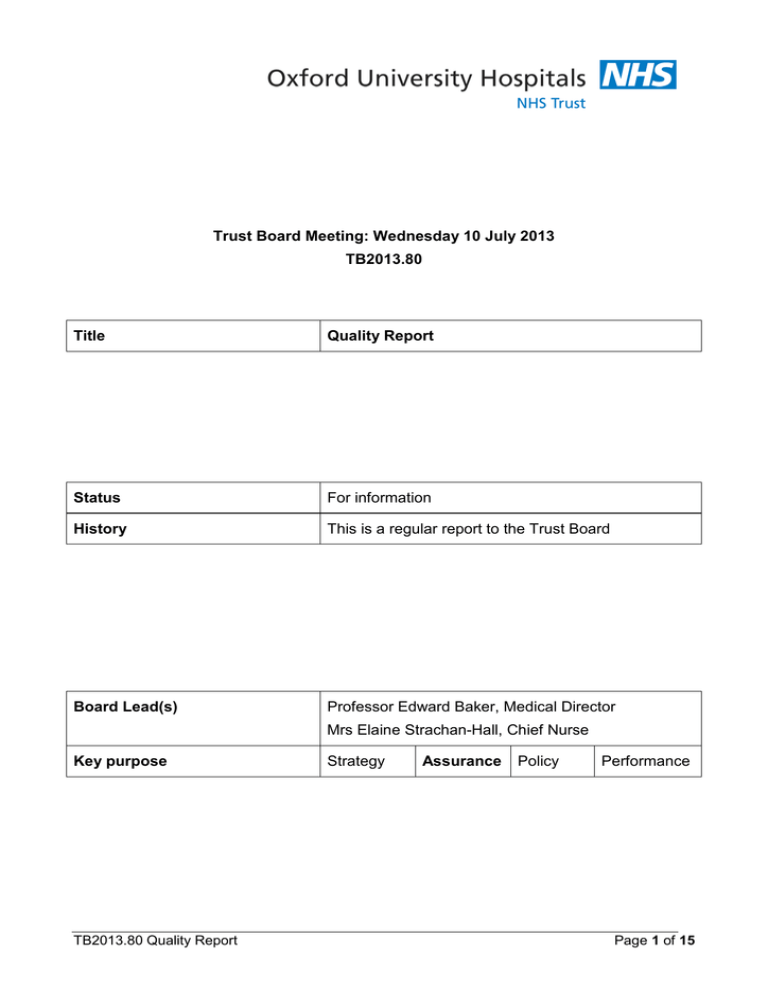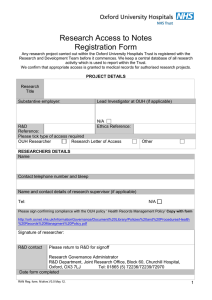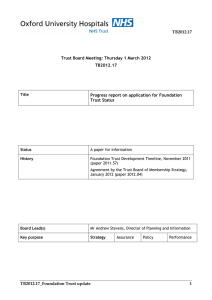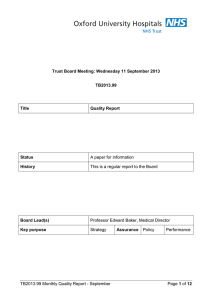For information This is a regular report to the Trust Board
advertisement

Trust Board Meeting: Wednesday 10 July 2013 TB2013.80 Title Quality Report Status For information History This is a regular report to the Trust Board Board Lead(s) Professor Edward Baker, Medical Director Mrs Elaine Strachan-Hall, Chief Nurse Key purpose TB2013.80 Quality Report Strategy Assurance Policy Performance Page 1 of 15 Oxford University Hospitals TB2013.80 Summary 1. HSMR/SHMI – Risk-adjusted mortality measures for the OUH are currently within expected limits. 2. Quality Account – The Quality Account has been prepared in accordance with the associated regulations, and will have been published when the Board meets. 3. CQUINS – CQUINS for 2013/2014 have been agreed with the Clinical Commissioning Group. 4. Reported Incidents – The top six incident categories account for 53% of the total amount reported (17646) in the 12 months from June 2012 to May 2013. 5. Serious Incidents Requiring Investigation (SIRIs) – Nine SIRIs were reported in May 2013, of which 5 were hospital acquired pressure ulcers. 6. Quality Concerns raised by staff – Nil raised in May. An update is provided on issues previously highlighted. 7. Executive walk rounds – Six walk rounds were completed in May 2013. 8. Patient Safety – The NHS Patient Safety Thermometer indicated a ‘harm free’ rate of 92.11%. This is a 0.4% decline from the previous month (92.51%). 9. Central Alerting System – 12 new alerts received in May 2013. 2 alerts remain open at the end of the month of May 2013. One alert breaches timescales for closure (in common with seventy other Trusts). 10. Complaints – A total of 66 complaints were received during May 2013, two of which were graded as red. 11. Friends and Family Test – There were 924 Friends and Family Test responses from patients in May with 90% of patients stating that they would be extremely likely or likely to recommend their ward / ED. The response rate for eligible patients in May was 11%, down from the response rate in April (>15%). 12. Infection Control – 11 cases of Clostridium difficile have been identified from samples taken after three days of admission. This total represents new cases from 1 April to 31 May 2013 (8 new cases April 2013, and 3 new cases May 2013). The Trust remains within / at its ceiling. TB2013.80 Quality Report Page 2 of 15 Oxford University Hospitals TB2013.80 Mortality Risk adjusted mortality measures 1. All risk adjusted mortality measures are within the expected ranges. 2. Research published in the British Medical Journal reported that mortality rates were 44% higher for patients having elective operations on Fridays in the UK. The paper suggested this may be due to an increased risk of complications within the first 48 hours after surgery and reduced or locum staffing levels at weekends. An analysis of Dr Foster data shows that mortality rates at the OUH for elective surgery on Fridays (April 2009 – February 2013) is within expected limits. A further more detailed analysis of mortality rates by day of the week will be carried out over the next month. Audits related to HSMR rebasing (2012/13) 3. The annual recalibration (rebasing) of the HSMR by Dr Foster will occur in September 2013, this process effectively increases the HSMR of all Trusts by up to 10 points. The tool provided by Dr Foster to predict rebased HSMR currently estimates the rebased HSMR at the OUH to be 104. As shown in the funnel plot below, this is within the expected range. Figure 1 Quality Account 4. The Quality Account was prepared in line with the regulations, and was approved on behalf of the Trust Board by the Quality Committee on 12 June 2013. 5. External assurance by Ernst and Young has taken place, with two key performance indicators being assessed: • • Percentage of patient safety incidents resulting in severe harm or death Rate of Clostridium difficile infections TB2013.80 Quality Report Page 3 of 15 Oxford University Hospitals TB2013.80 CQUINS 6. The agreed CQUINs for 2013/14 are described in table 1 below. 7. The Trust must meet half of the six ‘pre-qualifier’ CQUINs as a gateway to the overall CQUIN scheme. CQUIN values are derived from Oxford Clinical Commissioning Group (OCCG) and ‘associate commissioners’ for ‘local’, specialist commissioners for ‘specialist’, and all three groups for ‘national’. 8. The following Quarter 1 (Q1) targets have been confirmed as met by the Clinical Commissioning Group: • Baseline Data for elderly patients and DTOC. • Medical support for complex patients in surgery. 9. The remaining Q1 targets are expected to have been met by the end of June 2013. 10. Financial targets for national and Local CQUINS targets are outlined in the table below. Table 1 Pre-qualifiers Update Telemedicine Suitable scoped. Intra operative fluid monitoring Ahead of current trajectory. n/a Child in the chair Maintaining a five week wait. n/a ICE Expanded to radiology. n/a for BRC funded study in place. n/a Reduction in antenatal gestational diabetics visits CQUIN Value equipment being n/a Physiological outcomes post MI Jointly funded study in place. n/a National CQUINS: Update CQUIN Value Friend and Family test Exceeding target. £784,677 Safety Thermometer Strategy in place to improve £784,677 reporting. Potential to adjust the baseline after 6 months. 50% reduction in pressure ulcers Dementia • Assessment of patients • Leadership • Support for carers TB2013.80 Quality Report Strategy formulated to £784,677 improve performance in all three areas. Very high risk in relation to delivery of assessment component. Page 4 of 15 Oxford University Hospitals VTE Target = 95% assessed TB2013.80 Exceeded 95% in April and £784,677 May. Local CQUINS: CQUIN Value Psychiatric liaison service £650,132 Baseline data for frail elderly patients + DTOC £805,297 Medical Support for complex patients in surgery £1,087,497 Emergency Admission Navigators £1,397,047 Nursing £758,747 Diabetic foot disease £236,041 Diabetic support for young adults (19-25yr old) £197,250 Learning disability £236,041 ECIST report – Action Plan £1,117,750 Specialist CQUINS: CQUIN Value Clinical dashboards £756,688 Highly specialised services £756,688 Renal transplant – cold ischaemia times £908,025 Haemophilia £908,025 IV immunoglobulin £908,025 Major Trauma £908,025 Neonatal ICU – complex discharge £908,025 TOTAL £15,678,011 TB2013.80 Quality Report Page 5 of 15 Oxford University Hospitals TB2013.80 Incident Reporting Figure 2 Top six categories of incidents from June 2012 to May 2013 Table 2 Jun 12 Jul 12 Aug 12 Sep 12 Oct 12 Nov 12 Dec 12 Jan 13 Feb 13 Mar 13 Apr 13 May 13 Tota l 175 157 159 96 241 201 156 185 191 183 241 244 2229 119 140 123 132 135 131 135 204 172 210 266 235 2002 Slips Trips and Falls Appointment, Admission, Discharge & Patient Transport Documentation and Records (including EPR) 206 190 195 201 213 241 245 231 245 222 217 228 2634 66 101 89 67 89 104 94 109 111 94 127 103 1154 85 92 75 77 143 126 97 80 107 90 106 119 1197 Communication 112 76 84 53 45 65 53 70 58 60 67 84 827 Medication Incidents/ Events Pressure Ulcers and Skin Integrity 11. There continues to be an increase in reporting of clinical incidents across the organisation. This is reflective of a positive safety culture. 12. The top six reported incidents remain static as per previous months. SIRIs for May 2013 13. Nine SIRIs were reported to the CCG in May 2013 as listed in table below: TB2013.80 Quality Report Page 6 of 15 Oxford University Hospitals TB2013.80 New SIRI’s reported by Division Table 3 SIRI Ref 2013/015 2013/016 2013/017 2013/018 Division S&O NTSS C&W EMTA 2013/019 2013/020 2013/021 W&C EMTA EMTA Dept SEU SSIP Women’s Adams Ward Maternity HGH 7D and 7F SSW 2013/022 CCTADP Anaesthetics 2013/023 EMTA/ MARS 7B/EAU/F WARD/BIU Date of Incident 03/03/2013 09/03/2013 02/05/2013 06/03/2013 Date SIRI called 09/05/2013 10/05/2013 13/05/2013 13/05/2013 13/04/2013 05/04/2013 12/04/2013 28/05/2013 28/05/2013 28/05/2013 25/04/2013 05-04-2013 and 09-042013 30/05/2013 Death of new-born Death of patient following fall Pressure Ulcer Patient harm following anaesthetisia 31/05/2013 Pressure Ulcer Description Pressure Ulcer Pressure Ulcer Information Governance Pressure Ulcer 14. New SIRI’s reported for the month of May 2013 indicate an increase in reported hospital acquired pressure injuries. There is an organisation wide action plan in place that is monitored through the Patient Safety Committee. SIRI investigations launched Figure 3 Quality Concerns Raised by Staff 15. No new quality concerns have been raised. 16. The Trust Board was informed about concerns raised in May and June 2013. Updates as follows: a. Access to out of hours emergency gynaecology theatres – these concerns are being taken forward as part of an overarching review of prioritisation for emergency theatres on the John Radcliffe Site. A paper from CCTA is due to be presented at the Clinical Governance Committee on 17 July 2013. TB2013.80 Quality Report Page 7 of 15 Oxford University Hospitals TB2013.80 b. Volume of work in the Emergency Departments – it is recognised that there have been difficulties in relation to capacity and flow in the ED both locally and nationally. The situation is actively monitored within the Division, efforts continue to improve flow through and from the Trust, and consultant recruitment to ED and Acute Medicine has continued. c. Ophthalmology clinic management – work is being undertaken by the Operations and Service Improvement Directorate, supported by Newton, to analyse and re-profile clinics in order to ensure that they run at maximum efficiency. Ophthalmology staff members are contributing to this work. d. Nurse staffing and behaviours in neurosciences – an investigation has been undertaken by a senior nurse external to the Division into the concerns raised. Her report and recommended actions are being considered by the Directorate / Divisional team. A meeting with the Deputy Chief Nurse is planned during July. e. Concerns put forward by trainees through the General Medical Council annual trainee survey – responses and comments are being sought from the relevant clinical leads and will be considered at Clinical Governance Committee on 17 July 2013. Executive Walk rounds 17. There have been six Executive walk rounds in May 2013. 18. The key issues with the potential to affect quality or patient experience included a lack of specialist beds following relocation of a ward, and a reduction in bed capacity connected with cessation of emergency surgery at the Horton General Hospital. As a result patients may not have had timely access to specialist clinical staff and are potentially waiting longer than before for emergency surgery. In other areas the impact of vacant clinical posts was highlighted as having an impact on delivering optimum care and service. In one area, during the recruitment process successful applicants have withdrawn before taking up appointment. In two clinical areas within a PFI, an issue with emergency call bells was raised. In both instances the buzzers cannot be heard in all areas of the department and both areas are struggling to resolve the issue with the contractor. All issues have actions associated with them and these will be monitored through Divisional governance processes. Patient Safety 19. The NHS Patient Safety Thermometer indicated a ‘harm free’ rate of 92.11%. This is a 0.4% decline from the previous month (92.51%). When identifiable ‘old’ harms are removed from the data, the ‘harm free’ rate is 96.83%, improved by 0.08% from the previous month (96.75%). TB2013.80 Quality Report Page 8 of 15 Oxford University Hospitals TB2013.80 20. Detail of the ‘harm free’ care rate for the past 3 months within the OUH is provided in table below: Table 4 March April May Number of Patients 1148 1107 1103 ‘Harm Free’ Care % * 96.78 96.75 96.83 *’Harm free’ rate when ‘old harms’ are removed from the data. 21. There was an increase in the number of pressure ulcers of one between April and May, however there was a decrease over the quarter, reported through the Safety Thermometer, and these present as the majority of ‘new’ harms in the OUH. The table below details new pressure ulcers by category March to May 2013: Table 5 Category 2 Category 3 Category4 March 1.66% (n19) 0.17% (n2) 0 April 1.17% (n14) 0.09% (n1) 0 May 1.09% (n12) 0.36% (n4) 0 22. The strategy to reduce pressure ulcers across the health economy was outlined in a separate paper and action plan to the Trust Board in May 2013. Figure 4 % New Harms - Pressure Ulcers Percentage of patients harmed Chart X: New P.U. % 3 2 1 0 July Aug Sept Oct Nov Dec Jan Feb March April Feb March April Month Figure 5 % New Harms - Falls Percentag of patients harmed Chart X: Falls with harm % 3 2 1 0 July Aug TB2013.80 Quality Report Sept Oct Nov Dec Jan Month Page 9 of 15 Oxford University Hospitals TB2013.80 Percentage of patients harmed Figure 6 % New Harms - CAUTI New CAUTI % 2 1.5 1 0.5 0 July Aug Sept Oct Nov Dec Jan Feb March April Jan Feb March April Month Figure 7 % New Harms - VTE ercentage of patients harmed Chart X: New VTE% 1.5 1 0.5 0 July Sept Aug Oct Nov Dec Month Central Alerting System (CAS) 23. A total of 12 new alerts were received in May 2013. As of the 31 May 2013, 1 MDAs and 1 NPSA remained open. The remaining open NPSA alert, which was breaching the deadline, related to equipment for making safe connections to spinal and epidural needles, and the lack of suitably tested equipment in the market place. The Trust is contacting those Trusts who have closed the alert to see what approach has been taken. 24. Twelve new Medical Device Alerts (MDAs) were received in May 2013. Ten MDAs were due for closure in May 2013 all of which were closed before the deadline. Two Estates and Facilities Alerts (EFAs) were due for closure in May 2013; one was closed before the deadline and one closed on the day of the deadline. Table 6 Month May 2013 CAS Alerts received May 2013 MDA NPSA EFA MDA NPSA EFA Number breaching deadline 12 0 0 1 1 0 1 New alerts issued TB2013.80 Quality Report Open at end of month Total open 2 Page 10 of 15 Oxford University Hospitals TB2013.80 Complaints 25. The number of formal complaints received in May (66) presented as a decrease compared to April (78). Figure 8 below illustrates the complaints trend for the last year. Table 7 illustrates the complaints trend for a three-year period against total OUH activity. Figure 8 Table 7 OUH complaints trend June 2012 – May 2013 OUH Complaints for 2010/11 – 2012/13 (FY) in context of activity Financial Year Total OUH activity % of activity 2010-11 1101845 0.075% 2011-12 1135868 0.076% 2012-13 1145846 0.075% 26. The table below shows the number of Finished Consultant Episodes (FCEs), including outpatient appointments attended, ED attendances and inpatients, per Division, for the period May 2012 to May 2013, together with the corresponding number of complaints received and the corresponding percentages. TB2013.80 Quality Report Page 11 of 15 Oxford University Hospitals Table 8 TB2013.80 Complaints and Finished Consultant Episodes (FCEs) Division Activity May 2012 to May 2013 Complaints May 2012 to May 2013 % Cardiac Thoracic & Vascular 60576 41 0.06% Critical Care Theatres Pharmacy &Diagnostics 172172 62 0.04% Children & Women’s 159810 127 0.07% Emergency Medicine & Therapies 329256 165 0.05% Musculoskeletal & Rehabilitation 134585 81 0.06% Neurosciences, Trauma & Specialist Surgery 256834 198 0.07% Surgery & Oncology 289812 201 0.06% Figure 9 Complaints Themes 2013 - YTD New Complaints – May 2013 27. Of the 66 new complaints, 2 were graded red as follows: • Parents believe poor care during labour contributed to death of baby; • Elderly gentleman admitted to the JR Hospital following a fall at home, he was transferred to community hospital with undiagnosed fractures. Management of complaints 28. In May, all complaints were acknowledged within the statutory 3 working days. Ombudsman Investigations 29. There was one request from the Parliamentary and Health Service Ombudsman in May. 30. This request was from the wife of a deceased patient with on-going concerns regarding her husband's clinical oncology out-patient consultation on 27 February 2012 and subsequent emergency admission to the JR resulting in emergency surgery due to a sigmoid perforation and abscess. The patient was terminally ill and passed away soon after admission. TB2013.80 Quality Report Page 12 of 15 Oxford University Hospitals TB2013.80 Patient Experience 31. Patient feedback data has been collated from 1222 items of feedback; this includes Friends and Family Test. The majority of comments (n=183) received excluding Friends and Family Test relate to issues that required resolution (61%). 12% of the feedback comments were positive and 13% in May were constructively critical (without an issue to resolve). Table 9 Types of comments received March – May 2013 Type March April May Issues that required resolution 169 66% 201 53% 183 61% Positive Feedback 36 17% 79 21% 36 12% Constructively critical Feedback 31 11% 56 15% 40 13% Advice/ information request 19 5% 23 6% 21 7% Mixed positive and negative 6 1% 8 2% 8 3% Other 0 0.4% 9 2% 10 3% 32. Table 10 below provides a summary of the top four feedback topics from the above data. More detail will be presented in August within the patient experience report. Table 10 Top four patient feedback issues Top four patient feedback issues March April May Appointment, treatment and discharge delays 89 118 91 Communication, consent and confidentiality 43 48 36 Caring, friendly and helpful attitude/high quality care 42 88 37 Car parking issues 4 11 12 33. There were 924 Friends and Family Test responses from patients in May, 1335 in April, and 635 in March; 90% of patients said they would be extremely likely or likely to recommend their ward/ED in May (presented in figure 10, below). The response rate for May was 11%, down from the response rate in April (>15%). Individual clinical areas are being actively supported to increase their response rates. 34. The Friends and Family score (net promoter score) was 67 for May, 67 for April, 71 for March, and 65 in February (presented in figure 11; below). The percentage of patients who said they would be extremely likely or likely to recommend their ward/ED was 90% TB2013.80 Quality Report Page 13 of 15 Oxford University Hospitals Figures 10 & 11 TB2013.80 Family and Friends Test Results and Score Figure 10: Responses (n=924, don’t know is excluded from NPS calculations*) Figure 11: The Friends and Family Test Score (net promoter score *, NPS = extremely likely minus [unlikely + neutral + extremely unlikely]) Infection Control Figure 12 Number of Clostridium Difficile Cases per month 2012/2013 & 2013 – YTD 35. The OUH Trust has had 11 cases of Clostridium difficile identified from samples taken after three days of admission. The Trust remains within its objective to date. However, one case may be removed following review with Oxfordshire Clinical Commissioning Group (OCCG) as the patient did not have active disease or require any treatment. TB2013.80 Quality Report Page 14 of 15 Oxford University Hospitals TB2013.80 MRSA bacteraemia 36. The OUH Trust had one MRSA bacteraemia in May 2013. The patient was admitted having fallen at home, following which the patient required rehabilitation prior to discharge. During this admission, the patient developed an MRSA bacteraemia Quality Scorecards 37. The seven divisional quality scorecards are not being presented to the Trust Board this month. The relevant metrics (ward level hand hygiene, falls, pressure ulcers) are being monitored within Divisions and reported to the Clinical Governance Committee thorough Divisional Quality Reports. The format of the Divisional Quality Report, and in time the Trust Board Quality Report, is being revised. A new report format is anticipated for the September Board / Quality Committee meeting. Recommendations The Board is asked to receive the report and note the actions being taken. Professor Edward Baker, Medical Director Elaine Strachan-Hall, Chief Nurse July 2013 TB2013.80 Quality Report Page 15 of 15


